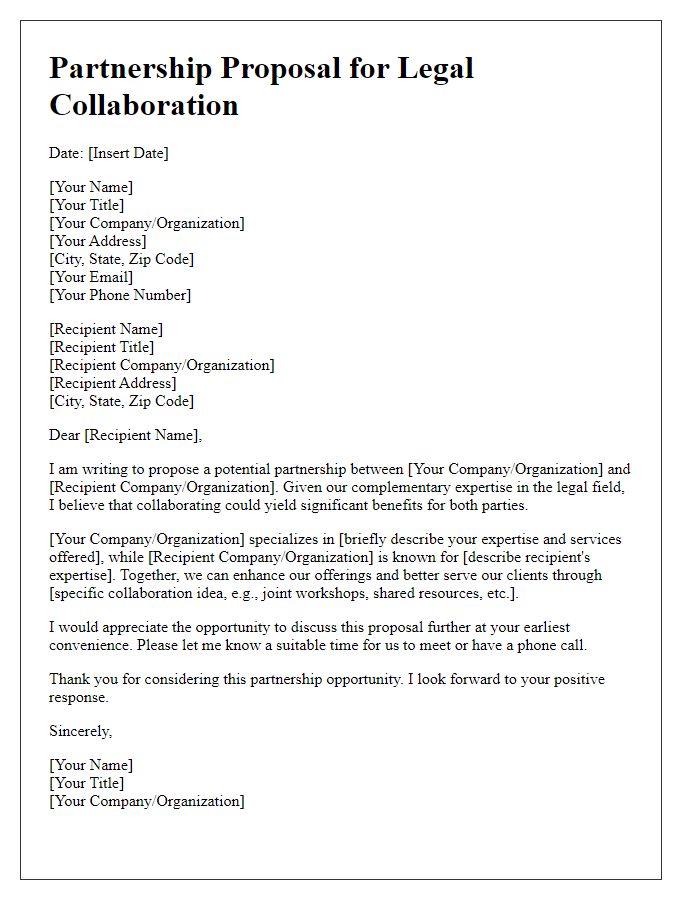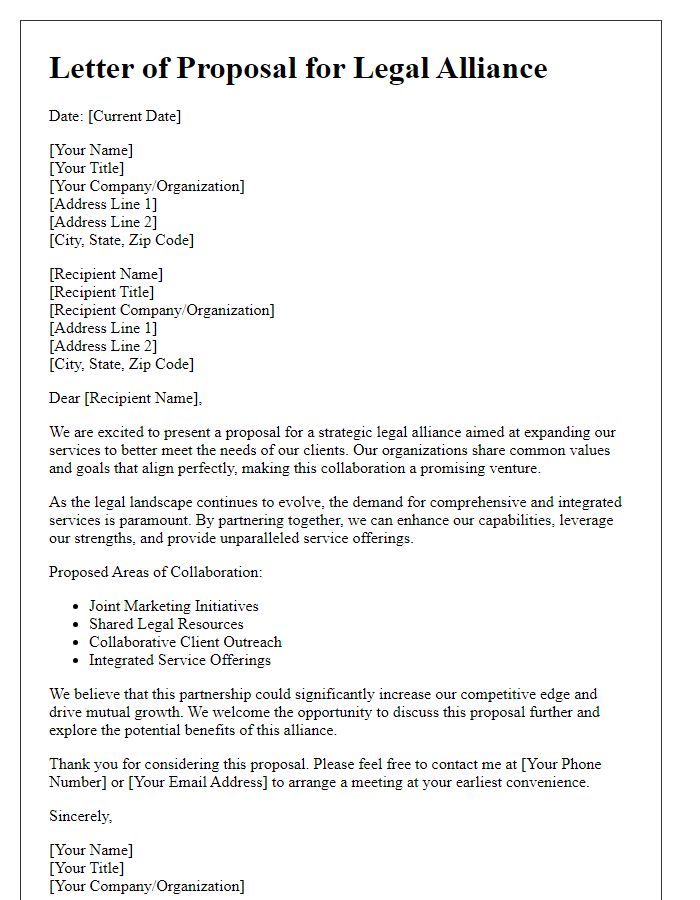Are you thinking about entering a legal partnership but unsure where to start? Crafting a well-structured partnership proposal is essential to outline goals, expectations, and shared responsibilities. In this article, we'll walk you through a handy letter template that covers all the key elements to ensure your proposal is comprehensive and clear. So, let's dive in and explore the ins and outs of creating a successful legal partnership proposal together!

Introduction and Purpose
An effective legal partnership proposal introduces the objectives and benefits of collaboration between entities. The introduction should emphasize the strategic value and alignment of interests, focusing on areas such as shared resources, expertise, and market advantages. The purpose of the proposal must clearly articulate the intended outcomes, which can include financial growth, increased market presence, and enhanced service offerings. Key elements like projected timelines, specific legal frameworks, and mutual goals should be defined to outline the foundation of the partnership. Emphasizing commitment to compliance with applicable laws and regulations reinforces the proposal's credibility, ensuring all parties work in a trustworthy and responsible manner.
Parties Involved
A legal partnership proposal outlines the agreement between involved parties, typically consisting of two or more entities. Each party, whether an individual, corporation, or organization, plays a crucial role in the partnership's structure. The significance of clearly identifying each party ensures accountability and clarity in the proposed legal obligations. Relevant details include names, addresses, and the nature of each entity's business operations. Notable considerations involve the legal status of each party, such as limited liability companies (LLCs) or corporations, which directly impact liability and financial obligations. Additionally, specifying the intended duration of the partnership, whether it be a fixed term or ongoing, enhances the proposal's clarity. Each party's contributions, responsibilities, and rights should be outlined to provide a comprehensive understanding of the partnership dynamics. Important terms such as profit distribution, decision-making processes, and dispute resolution methods should also be addressed to avoid future conflicts.
Objectives and Goals
A legal partnership proposal outlines the intentions of collaborating entities in a formal arrangement. Key objectives include establishing a mutual understanding to leverage complementary strengths for enhanced service delivery, such as sharing resources, expertise (e.g., legal specialists in contract law), and networks (professional connections within specific industries). Goals often encompass maximizing market reach in areas like real estate law or intellectual property rights, improving operational efficiency through combined efforts, and fostering innovation through collaborative projects or joint ventures. Furthermore, a well-defined governance structure ensures effective decision-making processes, and performance metrics (e.g., client satisfaction ratings) enable ongoing evaluation of the partnership's success.
Contributions and Responsibilities
In a legal partnership proposal titled "Contributions and Responsibilities", outlined contributions encompass the allocation of capital investment, intellectual property rights, and client relationship management. Responsibilities delineate the decision-making process, operational duties, and profit-sharing agreements. Each partner's financial input, whether it's cash investment or resource contributions, such as real estate or equipment, must be clearly defined, including the percentage of ownership implied by these contributions. The division of labor, often influenced by expertise, should specify who handles day-to-day management versus strategic planning. Profit-sharing ratios, established through negotiation, may reflect the level of involvement and risk assumed by each partner. Legal documentation should include clauses addressing conflict of interest, termination conditions, and dispute resolution mechanisms.
Legal and Financial Terms
A legal partnership proposal requires a comprehensive outline that covers critical elements of legal and financial terms. Key components include details on profit sharing percentages where partners agree to distribute earnings based on their investment or involvement, capital contributions outlining initial financial input from each partner, and a buy-sell agreement which provides a framework for the transfer of ownership shares, especially in case of death or withdrawal of a partner. Additionally, it's important to establish liability clauses that determine the extent of legal responsibilities among partners, confidentiality agreements that protect sensitive information, and dispute resolution mechanisms such as mediation or arbitration to efficiently resolve conflicts. Other essential aspects include the partnership's duration and procedures for termination, ensuring that all partners are aligned during the partnership lifecycle.













Comments